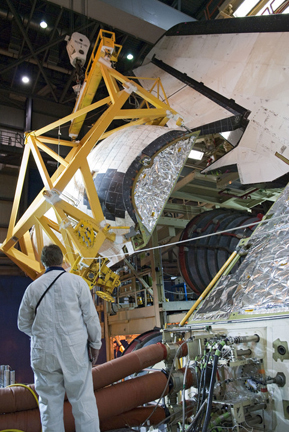Shuttle managers optimistic about leak repair, Tuesday launch
 |
| The shuttle Discovery's right-side orbital maneuvering system rocket pod during re-installation in July. (Photo: NASA) |
CBS News
KENNEDY SPACE CENTER, Fla.--The shuttle Discovery's launch on a space station resupply mission is being delayed from Monday to at least Tuesday -- election day in the United States -- to give engineers time to repair two leaking quick-disconnect fittings in pressurization systems used by the ship's right-side orbital maneuvering system rocket pod.
NASA Test Director Jeffrey Spaulding said the repair work is not complicated but it will require engineers to vent and then repressurize high-pressure helium gas in the OMS system, work that requires launch personnel to clear the pad.
As a result, the start of Discovery's countdown will be delayed one day, from Friday afternoon to 2 p.m. EDT (18:00 GMT) Saturday. Assuming the repair work goes well, launch will be re-targeted for 4:17:56 p.m. (20:17:56 GMT) Tuesday. Forecasters are predicting a 70 percent chance of acceptable weather Tuesday, Wednesday and Thursday.
Discovery's crew -- commander Steven Lindsey, pilot Eric Boe, Nicole Stott, Michael Barratt and spacewalkers Timothy Kopra and Alvin Drew -- flew to the Kennedy Space Center Thursday to prepare for launch. They will use the extra day to relax and review their flight plan.
Assuming an on-time launch Tuesday, Lindsey will guide Discovery to a docking with the International Space Station around 12:11 p.m. (16:11 GMT) Thursday, Nov. 4. Two spacewalks are planned Nov. 6 and 8 amid work to attach a cargo storage module and an external spare parts platform. Undocking would be expected around 6:05 a.m. (10:05 GMT) Nov. 11 with landing back at the Kennedy Space Center around 11:05 a.m. (15:05 GMT) on Nov. 13.
Lindsey said last week the astronauts voted early, expecting to be off the planet Tuesday or, if delayed, in a launch countdown. With early voting allowed through Saturday in Florida, Spaulding said NASA managers have been encouraging the launch team to vote early as well because of the possibility of a launch delay. But he said NASA plans to press ahead with a launching Tuesday, if possible, regardless of the election.
"That was something we recognized a long time ago, the possibility for the dates to line up," he said. "We did encourage the team, we did throughout the entire pad flow, to take advantage of early voting, absentee voting, because we certainly want to give everybody the opportunity to get out and (vote)."
The OMS pod pressurization problem cropped up overnight during work to prepare Discovery for the start of its launch countdown.
A leak was first noticed in a quick-disconnect fitting used to load nitrogen gas into the right-side orbital maneuvering system rocket pod to drive valves and to pressurize smaller propellant tanks. Engineers later discovered a helium leak in another quick-disconnect fitting where ground supply lines attach to the right OMS pod. High pressure helium is used to pressurize the main propellant tanks in the rocket pod.
"While we were doing our pressurization last night, our right-hand orbital maneuvering system helium tank vented down unexpectedly when we were venting the ground side ... which indicated we had an issue with our flight-side coupling between those two quick disconnects that allow gases to flow back and forth," Spaulding said.
"We did attempt to do some troubleshooting, repairs on that. They were unsuccessful. When we took the flight side off, we did notice there was part of a seal, an O-ring, in there, it looked like it came from the ground side. We did remove that and attempted to remate the disconnects and the couplings and we still were unsuccessful with the repairs."
After engineering meetings to discuss repair options, the team decided to replace the couplings on both sides of the interface. In preparation for the repair work, the helium tanks were vented. After the new components are in place, leak checks will be carried out followed by re-pressurization of the helium tanks.
"The big part of that whole process is the actual repressurization of those tanks, which is about two shifts, or 16 hours of work," Spaulding said. "The actual repairs, removal and replacement of those parts, isn't very complicated and we've done it in the past. ... It's a well known process and the folks do a very good job with that.
"But that's kind of the thing that's driving us, the need to depressurize our tanks and then repressurize them. That repressurization of the tanks requires a pad clear, which precludes us from doing the normal things we would do during a normal countdown. ... That's why we made the decision to push off 24 hours for the start of our countdown and subsequently the launch date as well."
The right-side OMS pod was re-installed in July after work to fix a helium isolation valve that had problems during Discovery's most recent mission in April. A leak in a fuel crossfeed line associated with the right OMS pod was repaired last weekend when two internal seals were replaced.
Spaulding said the current leaks are not related to last weekend's repair work or the rocket pod's removal and reinstallation.